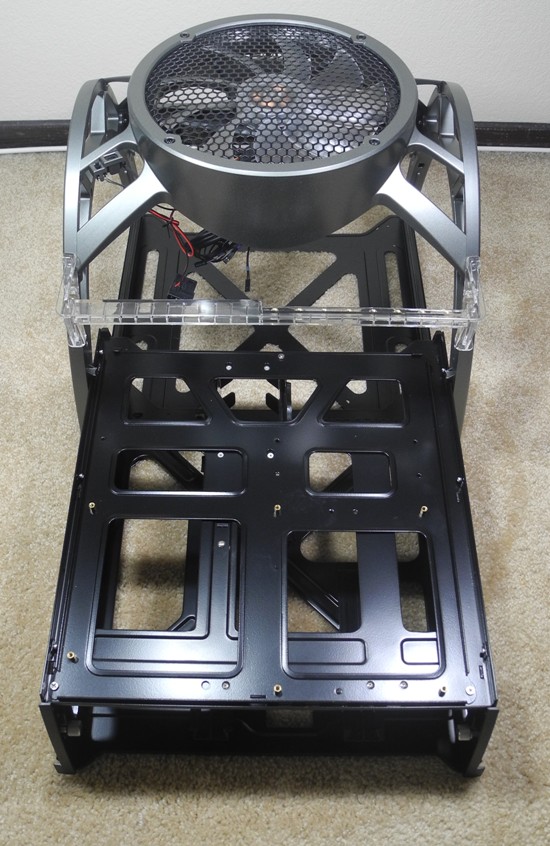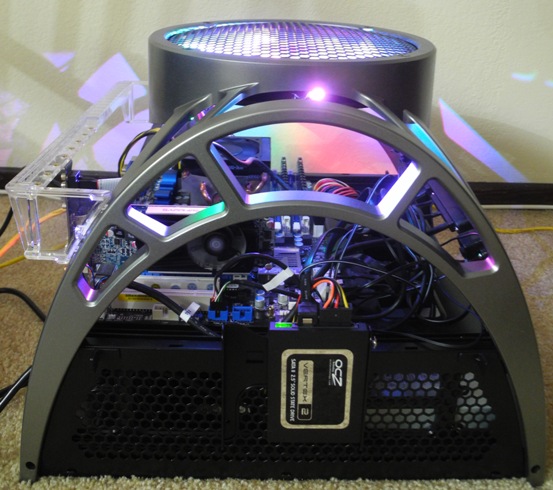AMD A8-3850 : An HTPC Perspective
by Ganesh T S on June 30, 2011 6:20 AM EST
AMD provided us with an A8-3850 CPU and an ASRock A75Pro4 ATX motherboard for the review. Purists might balk at the idea of a 100W TDP processor being used in tests intended to test the HTPC capabilities. However, we have to make do with whatever sample was sent to us. A look at the Lynx lineup indicates that the same product with a 2.6 GHz core clock (A8-3800) has a 65W TDP. I intended to underclock the CPU to 2.6 GHz. However, Llano clock adjustments are a minefield, as Ian points out in his ASRock Extreme6 review. The idle power usage in my testbed was good enough (as we shall see in a later section). My time was better spent debugging the HTPC related issues, and therefore, I didn't take the trouble to underclock.
As soon as I finished setting up the testbed, I found that Blu-rays would play correctly, but local file playback had a host of issues. Noise reduction and cadence detection wouldn't get activated for local files with ESVP on. Turning it off resulted in dropped frames and high load on the GPU. It was turning out to be very similar to the DDR3 based MSI 6450 we had reviewed earlier.
Being a new platform, BIOS updates for the ASRock A75 Pro4 were flying thick and fast. To confound the issue, different BIOS versions had different behaviors with the default UEFI settings. With some BIOS versions, even Blu-ray playback had the same issues as local files.
After going back and forth with AMD about the local file playback issue, we discovered that the BR softwares use a proprietary API for video playback from discs with DRM. For local file playback, most players use the DXVA API. These are different code paths and may result in different GPU utilization numbers.
Couple of days back, AMD finally discovered that the BIOS was forcing the shared GPU memory to an absurdly low value. The GFX memory settings forced by the user in the BIOS were also not honored. There was an update to the BIOS to fix this and set the default GFX memory to 512 MB. After this, both Blu-ray and local file playback improved enough for us to be able to get down to exhaustive testing. AMD did acknowledge that there exists an issue with local file playback having higher than normal GPU utilization, but that hasn't been resolved as yet.
The table below lists the components in our Llano HTPC testbed.
| AMD Llano HTPC Testbed Setup | |
| Processor | AMD A8-3850 - 2.90GHz, 4MB Cache (1MB/core) |
| Motherboard | ASRock A75Pro4 ATX |
| OS Drive | OCZ Vertex 2 120 GB |
| Memory | G.Skill Ripjaws Series 4GB (2 x 2GB) SDRAM DDR3 1333 (PC3 10666) F3-10666CL7D-4GBRH CAS 7-7-7-21 |
| Video Cards | None / Sapphire DDR3 6570 (for Crossfire) |
| Optical Drives | ASUS 8X Blu-ray Drive Model BC-08B1ST |
| Case | Antec Skeleton ATX Open Air Case |
| Power Supply | Antec VP-450 450W ATX |
| Operating System | Windows 7 Ultimate x64 |
| Display / AVR | Acer H243H / Onkyo TX-SR 606 + Toshiba Regza 37RV530U |
| . | |
The most important part of the testbed from a reviewer's perspective was the open air case from Antec. I had used the Antec VERIS Fusion MAX for the NAS / Fall 2010 HTPC testbed. The case was a HTPC beauty, and kept my lab neat and orderly (instead of having components all over the table and the floor). However, the fact that I had to open the case to swap PCI-E cards in and out made it slightly impractical.
The Antec Skeleton is a full ATX open air enclosure, and what really sealed the deal for me was the fact that the motherboard was easily accessible, and upto 4 SATA drives could be mounted on the side. It also has support for upto three 11" PCI-E cards. There are Quick Relase 5.25" and 3.5" bays, but I chose to mount only one optical drive in the 5.25" bay, leaving the rest open to route the cables. The four externally mounted 3.5" bays can also be used to mount 2.5" drives, as I did with the OCZ Vertex 2 SSD in the gallery below.
I keep moving my testbeds back and forth between the home theater setup with the bitstreaming / 24 Hz capable gear and the test lab upstairs with the ordinary monitors (so as to not disturb my family's usage of the HT gear). In the Antec Skeleton case, the grips on the top railing (on either side of the top fan) can be used as handles. This makes it very easy to carry around.
The fancy LED lights on top around the huge fan make it look very attractive and it is sure to turn heads.
The last thing was from an OC / gaming enthusiast viewpoint and not really from a reviewer's perspective!
Let us now proceed to the actual HTPC benchmarking of the Llano.


















104 Comments
View All Comments
patsfan - Sunday, July 10, 2011 - link
I have read, off and on for the last 7 years or so articles on Anandtech, however, the ONLY reason I come here anymore is the same reason I look at CNN from time to time. For a good laugh. What started off as a fairly serious website for reviews on all things peripheral, has now turned into an INTEL propaganda machine. Seriously, when you look at all the ads, all you see is INTEL, INTEL, INTEL. Anand, if you stepped back and looked at your website as it gets pulled up, you would see what we see, a website that is no longer objective, between Intel, and Crapple you've apparently lost your objective way. I look at the obvious, AMD is the underdog, and I'll pick the underdog every time, and as far as Apple goes, it's a hell of a marketing machine, but as far as equipment goes???? The I-phone was great 4 years ago, today, it is mediocre at best, and if you're into power computing, Apple has absolutely NO compelling entry. Sadly, I resign myself to the fact that this website no longer provides me with any stimulating information, other than being an Intel/Crapple bully pulpit........ Oh wellqqgoodhao - Sunday, July 17, 2011 - link
http://www.ifancyshop.comWomen's fashion, men's personality + shoes
Travel bagthat eye-catching jacket + super pack free shipping
zgoodbbb - Wednesday, July 20, 2011 - link
http://www.ifancyshop.comWomen's fashion, men's personality + shoes
Travel bagthat eye-catching jacket + super pack free shipping
morohmoroh - Friday, July 22, 2011 - link
puting northbrigde inside core CPU is wonderfull in age of 32 NM but than ....that GPU radeon is still shared ram outside the processor , and NB still have to hop in out to transfer data in and out from the socket .....and it shared too with other kinda data for system stored at ram socket ddr3discreet VGA have dedicated RAM and some indenpendet core CPU too like in Nvidia , i wondering GDDR5 VS DDR3 , which one is fastes speedt?........comboing VGA is another idea but all that handle via software not at hardware it self.... so far see there is just another decoder for movies aka films format
the northbridge itself inside or outside core CPU will stressing alot hardwork to transforming coming in out data from external socket RAM....and i think it will produce more heat itself at the core
how can NB self handle 64 Gigs? i read that phenom x6 are gonna be very hot to handle 16 Gigs
intel create DMI to handle data boost at Mobos ram pci etc ...and QPI for inner core data boost...
well i not preety sure 32 Nm liano architecture are work fines in real wordl practically electron flows handling data , speed etc.....and mobo compability to manage the potential of it
pushing external DDR3 speed to act like GDDR5 for integrated VGA on same dies core ?
and i dont really care about i3 etc with VGA too i think its just another variaton for marketing thats all..seem nothing significant inovation about nano tech age can do more beyond that...
maybe doctor OCt gonna say "the power of the sun in palm of my hand "LOL
cheers